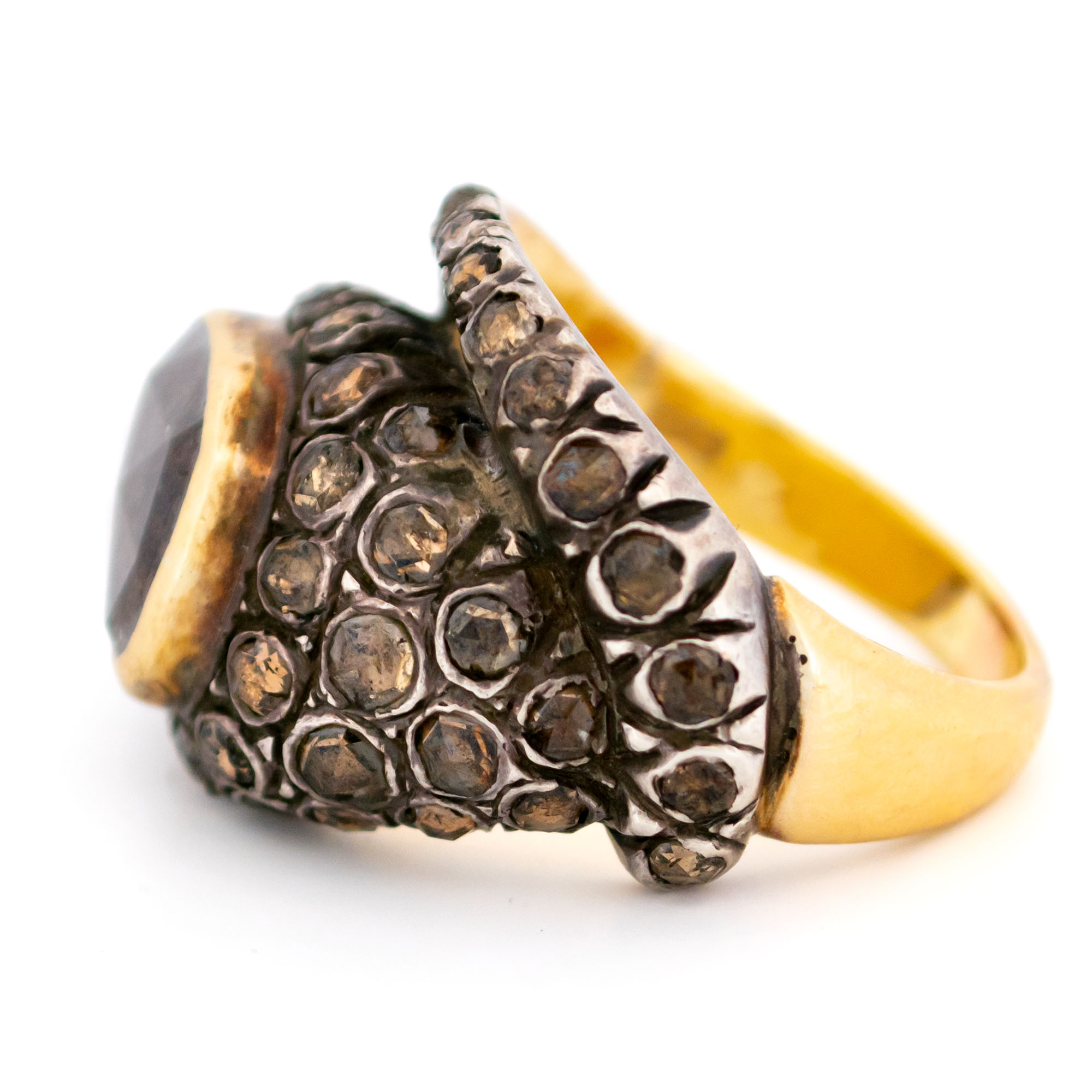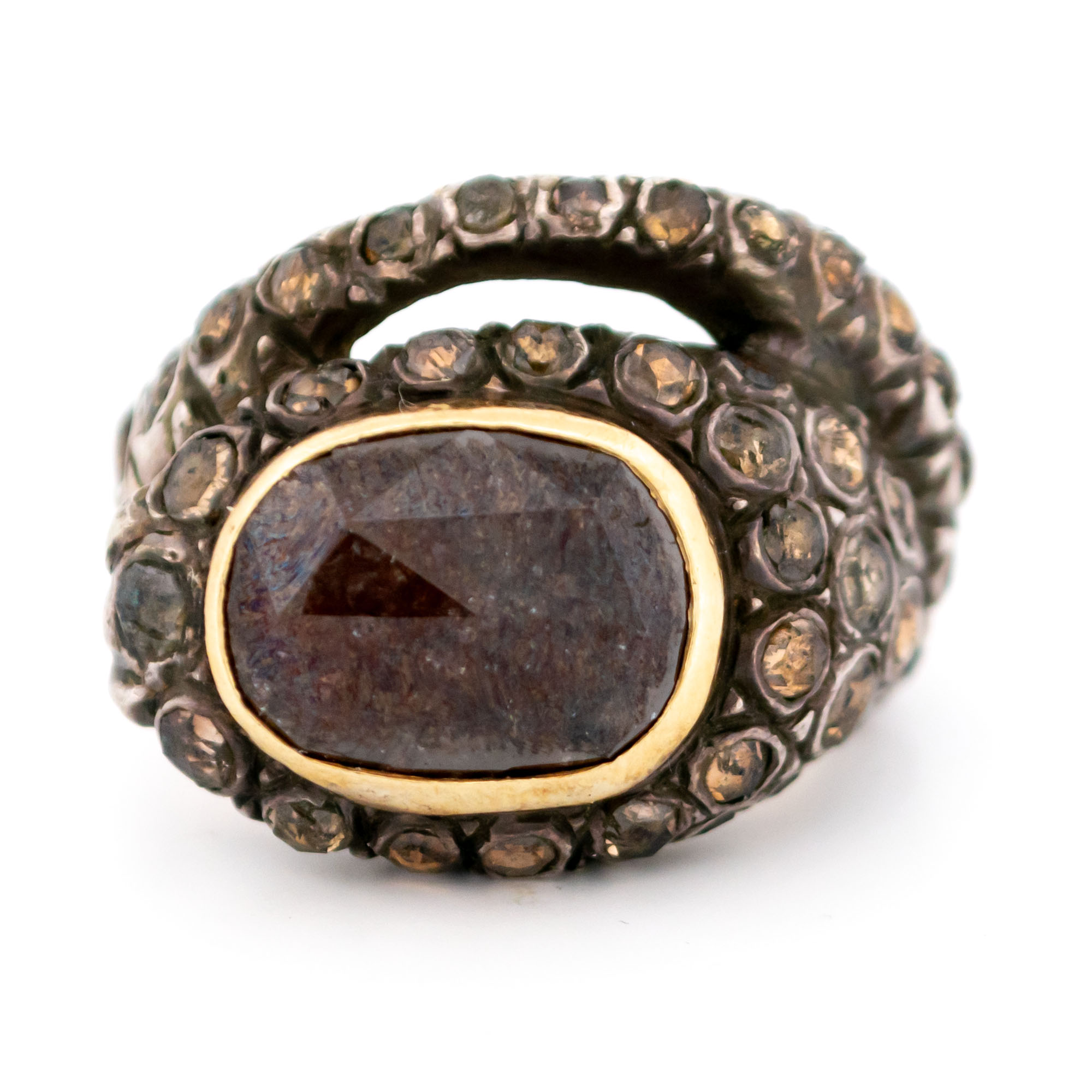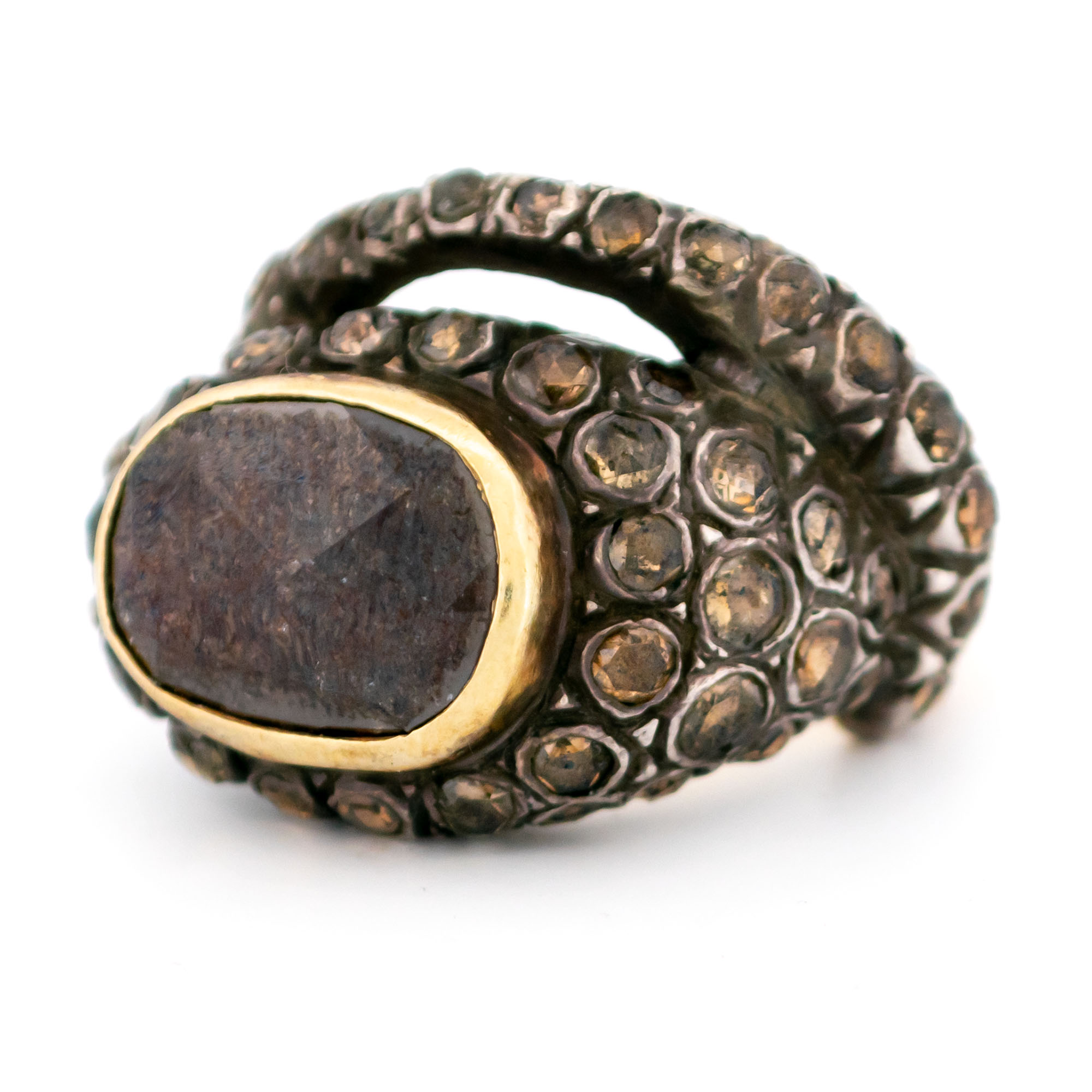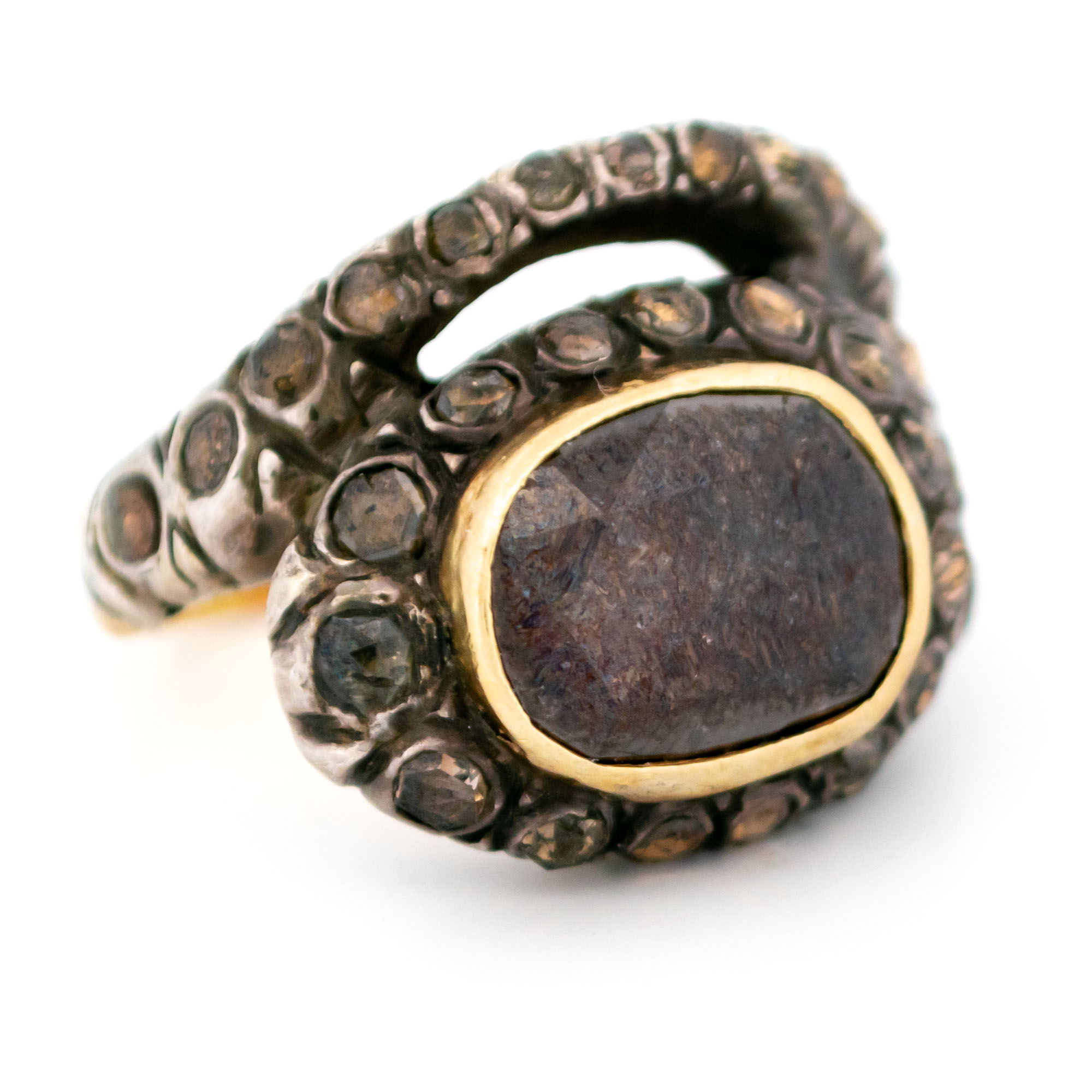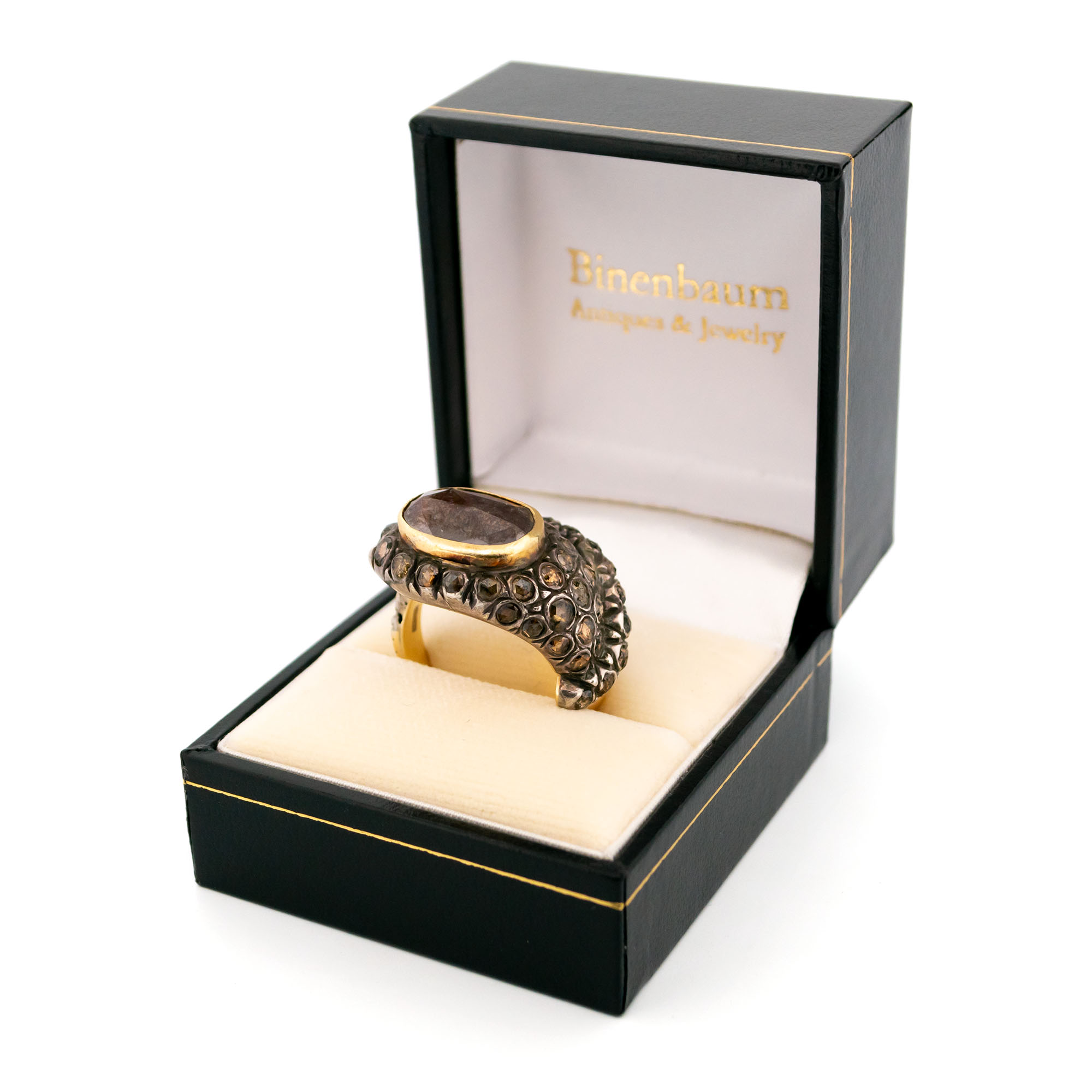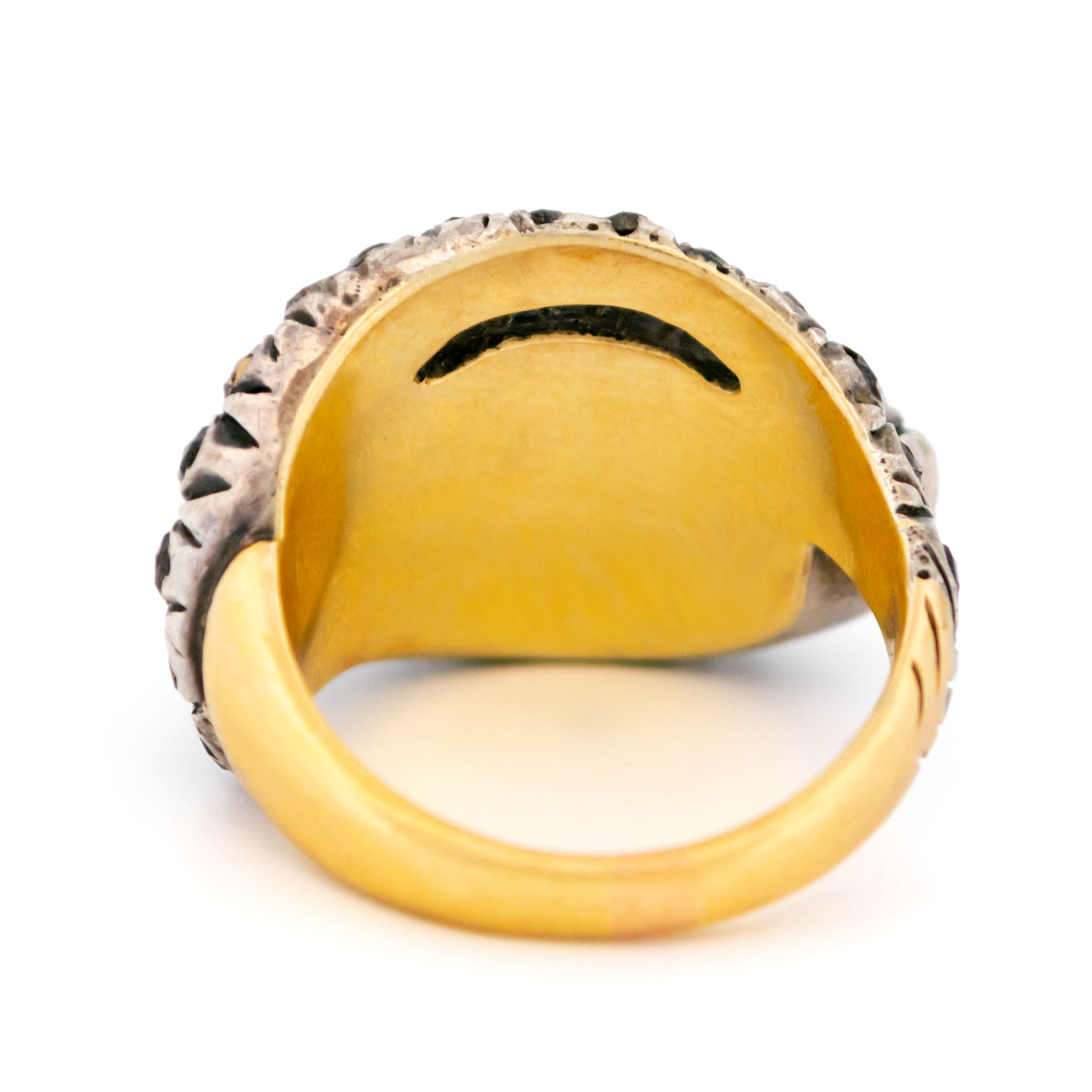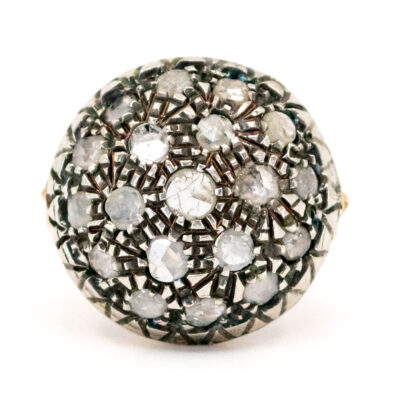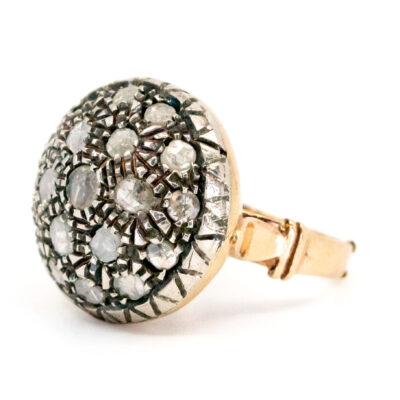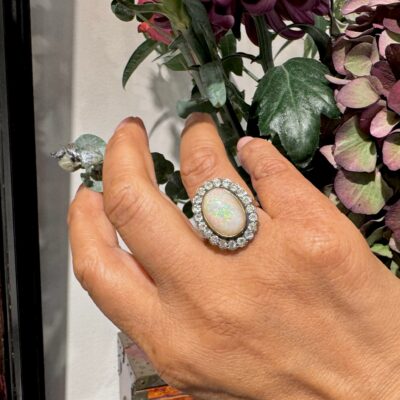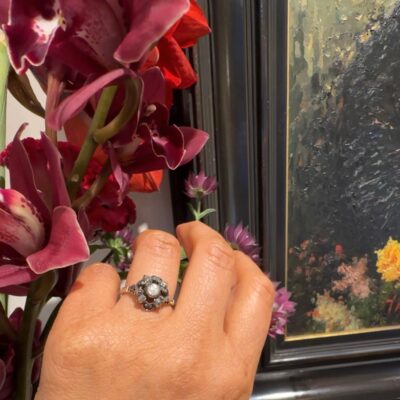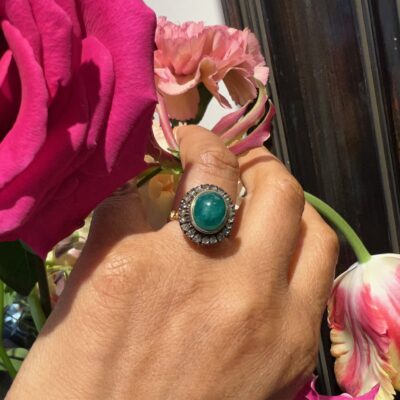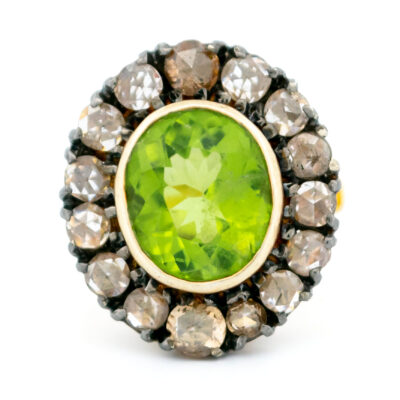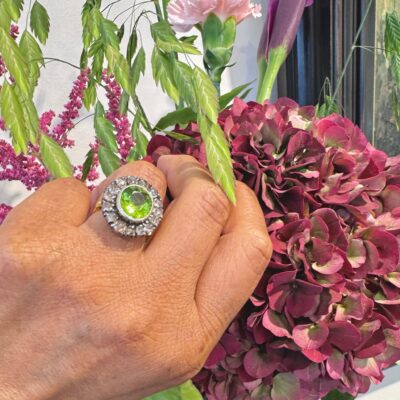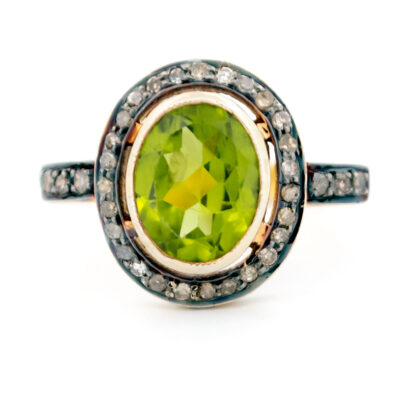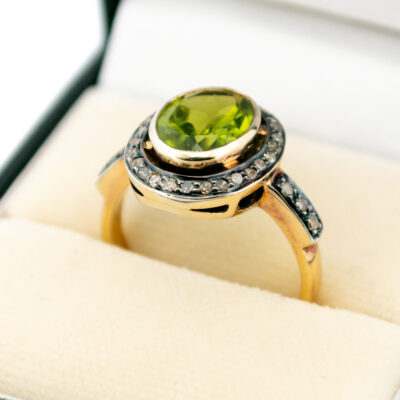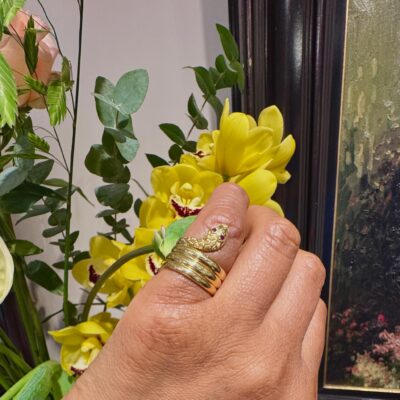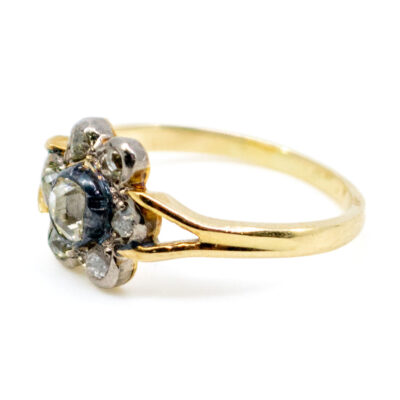This Victorian-style snake ring is an exquisite blend of history and artistry, featuring 4.00 carats of rose-cut diamonds. At its core, a large brown rose-cut diamond, bezel-set in 14k yellow gold, exudes an earthy elegance, its organic inclusions enhancing its antique charm. Encircling it, champagne and cognac-hued rose-cut diamonds, nestled in oxidized sterling silver, create a mesmerizing, textured surface reminiscent of serpent scales. A bold statement piece, this ring embodies eternal love, transformation, and protection, making it a treasured heirloom and a striking addition to any collection.
Details: ±4.00ct Rose-cut diamonds, 14k, Silver Ring.
Design Era: Vintage Victorian.
Weight in grams: 11.6.
Victorian-Style Snake Ring with Rose-Cut Diamonds
This exquisite vintage ring embodies the opulence of Victorian-era jewelry, featuring approximately 4.00 carats of rose-cut diamonds. Crafted from a harmonious combination of 14k yellow gold and 925 sterling silver, the ring’s dual-metal composition enhances both its durability and antique allure.
Historical and Cultural Significance: Victorian jewelry was deeply symbolic, often drawing inspiration from nature, mythology, and sentimentality. The serpent motif, which is the central design element of this ring, was particularly popular in the 19th century as a representation of eternal love, transformation, and protection. The rose-cut diamonds, one of the earliest styles of diamond cutting, further reinforce the historical authenticity of this piece. Their soft, vintage sparkle differs from the brilliance of modern cuts, evoking a timeless, old-world charm.
Modern Jewelry Appeal: This ring is a coveted treasure for collectors and vintage jewelry enthusiasts. The combination of oxidized silver and warm yellow gold, along with the rustic beauty of brown and champagne-hued diamonds, makes it a one-of-a-kind piece. Its bold, textured design is well-suited for those who appreciate antique aesthetics and statement jewelry.
Color and Finish: At the heart of this ring is a striking large brown rose-cut diamond, bezel-set in 14k yellow gold. This diamond possesses a deep, earthy hue with a mesmerizing organic quality, showcasing natural inclusions that enhance its character. The rose cut, with its faceted dome-like surface, lends the stone a subdued yet enchanting shimmer rather than a modern brilliant sparkle.
Surrounding the central diamond, numerous smaller yellow-brown rose-cut diamonds are meticulously set into the oxidized silver body of the ring. These accent diamonds vary in shade, ranging from warm champagne to deeper cognac tones, creating a visually rich tapestry. Their slightly irregular, hand-cut facets catch light subtly, giving the ring an understated yet sophisticated gleam. The darkened silver setting further enhances the contrast between the gems, making their golden hues stand out dramatically.
Design Versatility: Despite its ornate, antique-inspired design, this ring is surprisingly versatile. It can be worn as a statement piece, an unconventional engagement ring, or as part of a layered jewelry collection. The mix of warm and dark tones allows it to complement both vintage and contemporary jewelry styles.
Metaphysical and Practical Considerations: The snake motif has long been associated with rebirth, protection, and wisdom, making this ring a powerful talisman for personal transformation. The brown diamond at its center symbolizes grounding energy, stability, and a connection to the earth, while the champagne and cognac diamonds add an aura of warmth and abundance.
From a practical perspective, the bezel setting of the center stone offers added security, while the sturdy silver and gold construction ensures longevity. The oxidized finish minimizes the visibility of wear over time, making it an ideal heirloom piece.
Conclusion: This Victorian-inspired snake ring is a masterful fusion of history, symbolism, and craftsmanship. The interplay of the large brown rose-cut diamond, the smaller champagne-hued diamonds, and the antique metalwork creates a uniquely captivating aesthetic. A true statement of vintage elegance, this ring is a rare and meaningful addition to any fine jewelry collection.
Shipping and Pickup: This remarkable piece ships from our store located in the center of Amsterdam, The Netherlands. We offer both registered shipping and local pickup at our store. In the case of local pickup, any applicable shipping costs will be refunded.
About Us: Add some sparkle to your style with Binenbaum.com. We offer a stunning selection of antique and vintage jewelry that you won’t find anywhere else. From timeless rings and dazzling necklaces to unique brooches, we have something for every taste and occasion. Visit our website today and treat yourself to a piece of history.
| Design Era | |
|---|---|
| Design & Historical Context | The Victorian Era was a time of great cultural and artistic flourishing in England, and this was reflected in the jewelry of the time. During the Victorian Era, a middle class began to emerge, which sparked a demand for jewelry in the mass market. Jewelry trends during this time often reflected the tone of current events. The Victorian Era is usually divided into three subsections: the Romantic Period (1837-1861), the Grand Period (1861-1880), and the Aesthetic Period (1880-1901). During the Romantic Period, jewelry featured nature-inspired designs similar to those of the Georgian era, and was characterized by its intricate and delicate detailing. Lockets and brooches were popular for daytime wear, while colored gemstones and diamonds were worn in the evening. During the Grand Period, known as the Mid-Victorian era, jewelry was often influenced by the death of Queen Victoria's husband. Many jewelry pieces from this period have solemn, somber designs and feature heavy, dark stones such as jet, onyx, amethyst, and garnet. This period also saw the emergence of highly creative, colorful designs using shells, mosaics, and gemstones. During the Aesthetic Period, jewelers used diamonds and feminine, bright gemstones such as sapphire, peridot, and spinel. Star and crescent designs, as well as elaborate hat pins, were also popular. Some scholars believe that the Aesthetic Period began earlier, in 1875, and ended as early as 1890. |
| Key Materials | |
| Materials & Craftsmanship | Rose-cut diamond: The Vintage Gem of Romance and Light Rose-cut diamonds are a beautiful and romantic choice in the world of jewelry, known for their distinctive dome-shaped appearance and soft, glowing sparkle. This antique diamond cut, dating back to the 16th century, features a flat bottom and a domed top covered in triangular facets that resemble the petals of a rosebud—hence the name. Historically, rose-cut diamonds were highly prized during the Georgian and Victorian eras, often used in jewelry pieces meant to be worn in candlelight, where their gentle sparkle added a warm, intimate glow. Unlike modern brilliant cuts, which are designed for maximum fire and brilliance, rose-cut diamonds offer a more subdued, yet enchanting, reflection of light. In modern jewelry, rose-cut diamonds are cherished for their vintage appeal and unique charm. Their flat base and shallow profile make them perfect for creating low-profile, elegant designs that sit close to the skin, such as in rings, pendants, and earrings. Rose-cut diamonds are often used in vintage-inspired and bespoke pieces, where their historical elegance adds a touch of timeless romance. Rose-cut diamonds are more than just a gemstone choice; they are a symbol of understated beauty and classic romance. Their soft, luminous sparkle and antique allure make them an ideal choice for jewelry that tells a story and captures the essence of a bygone era. 14k: The Durable Choice for Everyday Elegance 14k gold is a popular and practical choice in fine jewelry, known for its durability, affordability, and beautiful color. The 14k signifies that the gold is composed of 58.3% pure gold and 41.7% alloyed metals, such as copper, silver, nickel, or zinc. This combination results in a strong and resilient material that can withstand the rigors of daily wear, making it an ideal option for those seeking both beauty and durability. Historically, gold has always been a symbol of wealth and luxury, and 14k gold strikes a perfect balance between the rich appearance of gold and the strength needed for everyday use. Because of its lower gold content compared to 18k or 24k gold, 14k gold is more affordable, making it a popular choice for a wide range of jewelry pieces. In modern jewelry, 14k gold is appreciated for its versatility and variety. It is available in several colors, each achieved by mixing gold with different metals: Yellow Gold: A classic and timeless choice, 14k yellow gold has a warm, golden hue that complements most skin tones and is well-suited for both modern and traditional designs. White Gold: Created by alloying gold with white metals like nickel or palladium, 14k white gold has a sleek, silver-like appearance. It is often rhodium-plated for added shine and is a popular choice for engagement rings and other contemporary jewelry. Rose Gold: Achieved by mixing gold with copper, 14k rose gold has a soft, pinkish hue that has gained popularity for its romantic and vintage appeal. It is a favorite for those seeking a unique and stylish alternative to traditional gold colors. 14k gold is commonly used in a wide array of jewelry, including rings, necklaces, bracelets, earrings, and watches. Its durability makes it especially suitable for pieces that are worn daily, such as wedding bands and engagement rings, where the balance between strength and beauty is crucial. 14k gold is more than just a practical choice; it is a symbol of enduring style and everyday luxury. Its ability to retain the look of gold while offering greater resistance to scratches and dents makes 14k gold a versatile and timeless option for any jewelry collection. Whether in a simple band or an elaborate design, 14k gold offers a perfect blend of elegance and durability that can be enjoyed for years to come. Silver: The Metal of Elegance and Versatility Silver, known for its bright, reflective luster, is one of the most beloved and widely used precious metals in the world. This versatile metal has been cherished for thousands of years, not only for its beauty but also for its malleability, making it ideal for crafting intricate and delicate jewelry designs. Historically, silver has been associated with the moon and considered a symbol of purity, clarity, and protection. Ancient civilizations, from the Egyptians to the Greeks and Romans, valued silver for its beauty and used it to create coins, jewelry, and religious artifacts. In many cultures, silver is also believed to have healing properties, often used in amulets and talismans to ward off negative energy. In modern jewelry, silver is prized for its affordability, versatility, and timeless appeal. Sterling silver, an alloy of 92.5% pure silver and 7.5% other metals (usually copper), is the standard used in high-quality jewelry. Its durability and bright, reflective surface make it an excellent choice for a wide range of designs, from minimalist pieces to ornate creations. Silver can be polished to a high shine or given a matte, oxidized, or antiqued finish to suit various styles. Silver is more than just a metal; it is a symbol of elegance, flexibility, and understated luxury. Its enduring popularity and wide-ranging applications make it a staple in jewelry that can complement any look, from casual to formal, with timeless grace. |
| Weight (in grams) | 11.6 |
By following these tips, you can enjoy your precious jewelry for many years to come.
Related Products
-
Diamond 9k Silver Cluster Ring 11052-6253
€ 1.495,00 VAT incl. (where applicable) -
Opal Diamond 14k Silver Cluster Ring 13295-8127
€ 4.695,00 VAT incl. (where applicable) -
Diamond 14k Silver Ring 16046-8719
€ 1.695,00 VAT incl. (where applicable) -
Emerald Diamond 14k Silver Cluster Ring 12730-8008
€ 3.495,00Original price was: € 3.495,00.€ 3.195,00Current price is: € 3.195,00. VAT incl. (where applicable) -
Peridot Diamond 14k Silver Cluster Ring 14609-8378
€ 3.695,00 VAT incl. (where applicable) -
Diamond Peridot 14k Silver Cluster Ring 14610-8379
€ 1.995,00 VAT incl. (where applicable) -
Ruby 18k Snake Ring 17071-9107
€ 1.895,00 VAT incl. (where applicable) -
Diamond 14k Silver Antique Ring 9302-6290
€ 1.695,00 VAT incl. (where applicable)
- Home
- Collection
- Fine Jewelry
- Silver Jewelry
- Silverware
- Boxes
- Candlesticks
- Salt and pepper shakers
- Miniatures
- Salt cellars
- Spoon Set
- Condiments
- Frames
- Napkin Ring
- Spoon
- Oddities
- Cups
- Vases
- Cutlery
- Serving Spoon And Cake Server
- Candlesticks
- Baskets
- Hanukkiah
- Spice Tower
- Yad
- Tea Set
- Sugar Castor
- Napkin Rings
- Wine Bottle Coaster
- Wine Stopper
- Tea Pot
- Jugs
- Rattles
- Hip Flask
- Miscellaneous
- Rings 💍
- About
- Contact
- No products in the cart.
